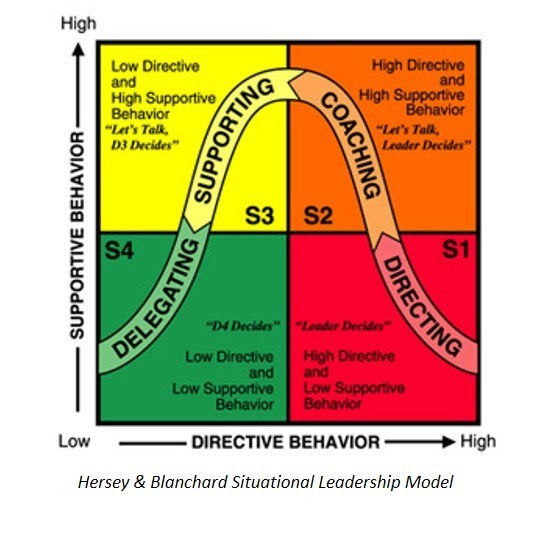Should you adopt a situational leadership style?
First, we need to understand what situational leadership is before we address the question of whether you should adopt a situational leadership style. Only then can we determine if it is an appropriate approach for you as a Christian leader.
Situational Leadership Model
Dr. Paul Hersey and Ken Blanchard first introduced the theory of situational leadership in 1969 while working on their book, Management of Organizational Behavior.
The theory of situational leadership suggests there is a best leadership style for every situation. The most effective leaders can adapt their leadership style to match the situation.
In their model, Hersey and Blanchard described four leadership styles: directing, coaching, supporting, and delegating.
- Directing: The directing leader tells the employee what to do and how to do it.
- Coaching: The coaching leader engages the employee in a discussion about what to do, but the leader ultimately makes the decision.
- Supporting: The supporting leader engages the employee in a discussion about what to do and allows the employee to decide what to do.
- Delegating: The delegating manager releases responsibility for deciding what to do to the employee.
So, a situational leader adapts their leadership style by directing, coaching, supporting, or delegating depending on which style will be most effective in each situation.
The challenge for most leaders is that we have a dominant leadership style, and we have trouble shifting between styles.
Every leader I ever worked with had trouble dealing with certain situations because of their dominant style. For example, some tended to micromanage (direct) an employee who was ready and able to go it on their own. Or on the other hand, they neglected their responsibility to lead by delegating work to an employee who was not ready for that level of responsibility.
So, to be an effective situational leader, the leader also needs to be situationally aware. In other words, they need to have the ability to assess the situation and determine which leadership style will be most effective. Then they need to shift their leadership style accordingly.
What Does Your Follower Need?
Therefore, the most effective leadership style is the one that gives the follower what they need. It is not about you as the leader but about giving your followers what they need.
- Do they need directing? You give them a clear, task-oriented direction.
- Do they need some coaching? You give them coaching that combines direction and support.
- Do they need your support to plan? You help them learn how to leverage their skills to accomplish a task.
- Are they ready to be on their own? You delegate.
It is difficult to shift from our dominant style to another style and do it effectively. But, if you think about the best leaders you know, my bet is they are strong situational leaders. They were able to direct, coach, support, or delegate, depending on what was needed at that moment.
So, now that we know what situational leadership is, let’s address the question of whether it is an appropriate approach for Christian leaders.
Jesus As A Situational Leader
Long before Hersey and Blanchard proposed their theory of situational leadership, Jesus showed us its power and effectiveness.
Remember, Jesus assembled this disparate group of twelve guys from Galilee. Several were fishermen, one was a tax collector, one was a Zealot, one was a Pharisee, and one turned out to be a thief. In short, if you were assembling a team of guys to turn the world upside down with the message of Christianity, these guys would have probably not been on your shortlist!
Yet, Jesus still saw the strength of every one of them, and in three years as their leader, he prepared them to take the message of the Gospel to the world.
Amazing, isn’t it! Do you ever wonder what kind of a leader Jesus was that he turned this group of workers into men willing to die for their new faith?
If we look through the scripture, we see Jesus, the ultimate situational leader. Jesus’ leadership gradually trained and developed the disciples, meeting each of their needs until they were ready to be on their own.
Here are just a few examples of Jesus exhibiting the traits of a situational leader.
1) Instructed
Jesus instructed the disciples when they were unknowing. As Jesus was preparing to send the disciples out for the first time to preach the Gospel and heal the sick, He gave them comprehensive instructions explaining what they should expect to happen, what to do, and what to say. (Matthew 10:11-40)
2) Explained
Jesus explained things when the disciples were confused. Often, when the disciples traveled with Jesus, they were confused about what he was doing and why. Their confusion was especially apparent when Jesus’ teaching came in the form of a parable. These parables taught important lessons but confused the disciples, so Jesus had to explain them.
3) Prodded
Jesus prodded the disciples when they needed to take action. This happened several times. One time when they had been out fishing and caught nothing all night. Jesus told them to put their nets on the boat’s other side. They secured a catch so large they could barely manage. (John 21:1-14)
4) Encouraged
Jesus encouraged the disciples when they were downcast. Jesus knew the disciples would face tremendous trials and tests. He encouraged them by teaching them to pray and never give up. (Luke 18:1-8)
5) Engaged
Jesus engaged the disciples when they were ready for the responsibility. The first time Jesus sent the twelve disciples out on their own, he gave them explicit instructions for where to go (do not go to the Gentiles but to the people of Israel), what to say (preach the Gospel), and what to do (heal the sick). (Matthew 10:5-14)
6) Empowered
Jesus empowered and commissioned the disciples when they were ready to go out on their own. When Jesus knew that His time was near, He empowered the disciples to continue their work of spreading the Good News. He told them precisely where to go (into all the world) and what to do (make disciples and baptize them). (Matthew 28:19-20)
Biblical Situational Leadership
Considering how Jesus led the disciples and comparing that to the Hersey and Blanchard situational leadership model, you’ll see they align very well.
- Instructing is directing leadership.
- Explaining and prodding are coaching leadership.
- Encouraging and Engaging are supporting leadership.
- Empowering is delegating leadership.
Jesus’ leadership of the disciples was so consistent and entirely appropriate for each person in each situation. Jesus knew what his followers needed, and, in every case, He supplied it.
If we aspire to be transformational leaders, we must learn to be situational leaders!
More Articles
I’ve written two other articles on the subject of situational leadership. Here they are:
- #110: 8 Steps to Create Your Barrier Busting Enabled Organization
- http://ronkelleher.com/368-a-balanced-leader-needs-to-be-part-rock-and-part-feather/
Join the Conversation
As always, questions and comments are welcome. Which leadership style is your dominant style? Are you a situational leader that can switch between leadership styles as needed?
I’d love your help. This blog is read primarily because people like you share it with friends. Would you be kind enough to share it by pressing the share button?
Category: Skills | Situational Leadership





